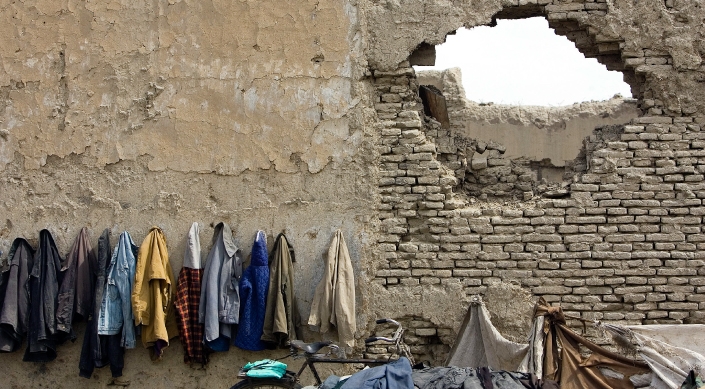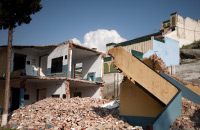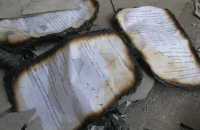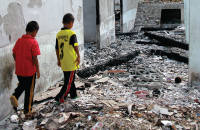Attacks on education are any intentional threat or use of force—carried out for political, military, ideological, sectarian, ethnic, religious, or criminal reasons—against students, educators, and education institutions.
Strengthening Monitoring and Reporting of Attacks on Education

Timely and accurate monitoring and reporting of attacks on education is crucial for responding to attacks, for holding perpetrators accountable, and for seeking to prevent attacks from occurring in the first place.
- Between 2013 and 2017, there were more than 12,700 cases in which schools or universities were attacked or used for military purposes, or in which students and educators were directly harmed, threatened, recruited into armed groups, or sexually abused.
- These attacks occurred in at least 70 countries and harmed more than 21,000 students and educators.
- Without information on where these attacks occur and why, or on who is harmed, it is almost impossible to provide assistance to victims, prevent them from occurring in the future, or encourage accountability. GCPEA is engaged in several activities to improve monitoring and reporting on attacks on education and our understanding their trends and dynamics.
THE EDUCATION UNDER ATTACK SERIES
Education under Attack is GCPEA’s flagship report. The series is serving as the primary source for reporting on indicator 4.a.3 on attacks on students, education personnel, and educational institutions, which monitors progress in implementing Sustainable Development Goal 4, Quality Education. The data from Education under Attack 2018 was released by the UNESCO Institute of Statistics in September 2018: http://data.uis.unesco.org/.
GCPEA took over responsibility for producing the series from UNESCO, which published studies in 2007 and 2010. Education under Attack 2007 was the first major document specifically addressing worldwide attacks on students, teachers, and educational institutions during armed conflict and insecurity. The more extensive 2010 volume served as a crucial advocacy tool in the lead up to Security Council Resolution 1998 (2011), which made attacks on schools and hospitals a trigger offense to the UN monitoring and reporting mechanism on children and armed conflict.
The 2014 and 2018 editions, published by GCPEA, are the most comprehensive and systematic reports on attacks on education to date. Education under Attack 2018 profiles 28 countries that experienced at least 20 attacks on education in the last five years. In addition to the 28 countries profiled, five or more incidents of attack on education were reported in 17 other countries.
Military use of schools or universities was reported at least once in 29 countries, including 24 of those profiled. These included cases in which armed forces or non-state armed groups used schools as bases, barracks, temporary shelters, fighting positions, weapons storage facilities, detention and interrogation centers, or military training facilities.
The next edition of the report will be published in 2020, and will report on attacks on education from 2018-19.
THE NEED FOR STRENGTHENING MONITORING AND REPORTING ON ATTACKS ON EDUCATION
- Monitoring and reporting on attacks on education has significantly improved as awareness of the issue has grown. Nevertheless, data collection continues to vary significantly from country to country, and insecurity in the places where attacks on education take place often makes it challenging to collect information.
- What and how data is collected differs from one context to another, and even within a single context over time. Those with the greatest access to information or responsibility to monitor may lack skills, resources, or motivation to monitor, or may face serious security threats to their own safety or that of witnesses. Reporting systems may be weak or non-existent or not linked to effective responses.
- Significant data gaps remain, particularly in terms of gender disaggregated data and specific violations, such as child recruitment or conflict-related sexual violence that occurs at schools. Moreover, current approaches for analyzing attacks on education do not sufficiently account for variation in the nature of incidents.
To address these challenges, GCPEA is convening a reference group to improve methods for analyzing attacks on education and is engaging in advocacy with partners to encourage more systematic reporting on attacks on education. These efforts will support future editions of Education under Attack.
RECOMMENDATIONS FOR STRENGTHENING MONITORING AND REPORTING OF ATTACKS ON EDUCATION
The Coalition urges States, local organizations, and relevant international agencies to:
- Strengthen and support existing monitoring and reporting mechanisms, and report attacks on education and military use of schools and universities to the UN-led MRM, Education Cluster, or other monitoring partners, as relevant.
- Ensure that monitoring systems collect and report data that is disaggregated by type of attack on education, sex, age, and type of schooling.
- Ensure that reports of child recruitment and conflict-related sexual violence specify where it takes places, including at schools and universities and along school or university routes, so they can be tracked as attacks on education.
- Work with legal, medical, and psychosocial service providers to establish referral mechanisms that allow victims of attacks on education to consent to sharing anonymized information with monitoring systems.
- Support the creation of a mechanism for reporting attacks on higher education. In the absence of a specialized mechanism, strengthen and systematize procedures for reporting attacks on higher education; for example, reporting to the relevant UN or regional rapporteurs or human rights bodies.
ADDITIONAL RESOURCES
-
Education under Attack 2018
-
Download PDF in: English
-
Visit the EuA 2018 website
-
Country Profiles: Afghanistan | Bangladesh | Burundi | Cameroon | Central African Republic | Colombia (en español) | Democratic Republic of the Congo | République démocratique du Congo | Egypt | Ethiopia | India | Iraq | عراق | Israel/Palestine | إسرائيل/دولة فلسطين | Kenya | Libya | دولة ليبيا | Mali | Myanmar | Nigeria | Pakistan | Philippines | Somalia | جمهورية الصومال الاتحادية | South Sudan | Sudan | جمهورية السودان | Syria | الجمهورية العربية السورية | Thailand | Turkey | Ukraine | Venezuela | Yemen | اَلْجُمْهُورِيَّةُ ٱلْيَمَنِيَّةُ |
-
-
Executive Summary of Education under Attack 2018
-
Education under Attack 2014
-
Download PDF in: English
-
-
A Summary of Education under Attack 2014
The Problem
Attacks on education violate the right to education and other internationally protected human rights applicable at all times.
Attacks on students, educators, and education institutions can have a devastating impact on access to education and education systems and on a society’s overall development in the long-term.



